Is The Approx ₹4,000 Crore Tax Concession For Political Donations Draining Funds From Public Services? Is The Common Citizen Paying For The Political Funding?
Tax concessions of almost ₹4,000 crore on donations to political parties! How has political funding in India dented its democracy?
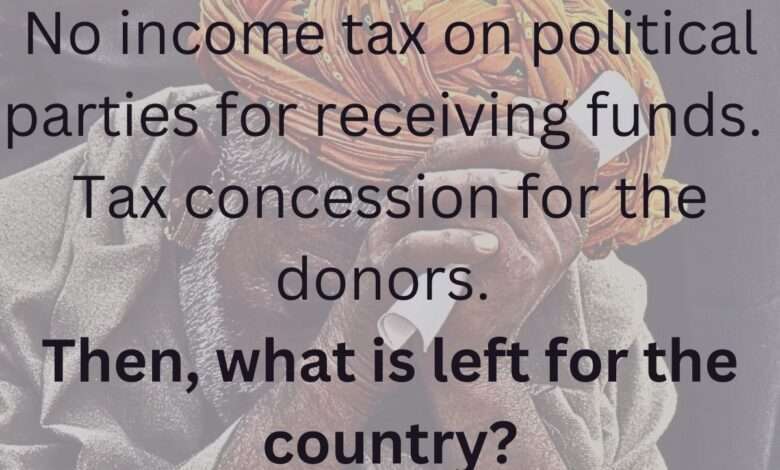
According to the Finance Ministry’s projections in the Union Budget 2024-25, the revenue impact of tax deductions claimed by corporations, businesses, and individuals for political party donations was an expected Rs 3,967.54 crore in FY 2022-23. The sum is 13% greater than in 2021-22, reflecting a continued increase in election funding over the last nine years. Tax exemptions for political donations were Rs 3,516.47 crore in 2021-22, up more than 300% from the previous fiscal year. In 2014-15, it totalled Rs 170.86 crore.
In India, political funding is a critical component of the electoral landscape, with significant implications for the functioning of democracy. A vital aspect of this funding is the tax concessions provided to political parties and donors. While intended to encourage political participation and support, these concessions have inadvertently had a substantial impact on the government budget, leading to concerns about fiscal sustainability and equitable resource distribution.
So, What are the Implications of Surge in Tax Concessions?
Tax exemptions on political funding have notably impacted the central government’s revenue in India. These exemptions, designed to encourage political participation and support, have inadvertently resulted in significant revenue loss.
Mechanisms of Tax Exemptions- Under Indian tax law, political donations benefit from several vital exemptions:
Tax Deductions for Donors: Contributions made to political parties and candidates are eligible for tax deductions under Section 80GGC of the Income Tax Act. This allows individuals and corporations to deduct donations from their taxable income, reducing their overall tax liability.
Income Tax Exemption for Political Parties: Under Section 13A of the Income Tax Act, political parties are exempt from paying income tax on funds received from donations. This means that the funds contributed to political parties are not subject to income tax, effectively allowing these funds to be used for party activities without any tax implications.
No income tax on political parties for receiving funds and tax deduction for the donors. Then, what is left for the country? This is where the repercussions of electoral financing and tax concessions on political funding arises!
Broader Fiscal Implications of Excessive Tax Concessions.
Increased debt.
One of the possible repercussions of such large tax concessions can be the increased borrowing for the government. To compensate for the reduced revenue, the government may need to increase borrowing. Higher borrowing leads to increased debt and as it can be seen from a published article on June 2024, titled ‘India’s external debt stands $663.8 billion at end-March 2024, rise of $39.7 billion from year before‘.
Even in December last year, the IMF stated in its annual Article IV consultation report that India’s general government debt, including the Centre and States, might reach 100% of GDP under worse conditions by fiscal 2028. According to them, “Long-term risks are high because significant investment is necessary to meet India’s climate change mitigation commitments and strengthen resilience to climatic stress and natural catastrophes.” This emphasises the need for additional, ideally concessional finance sources, as well as increased private sector investment and carbon pricing or an analogous mechanism.” However, the Finance Ministry refuted IMF estimates, stating that they are “a worst-case scenario and are not founded on factual positions.”
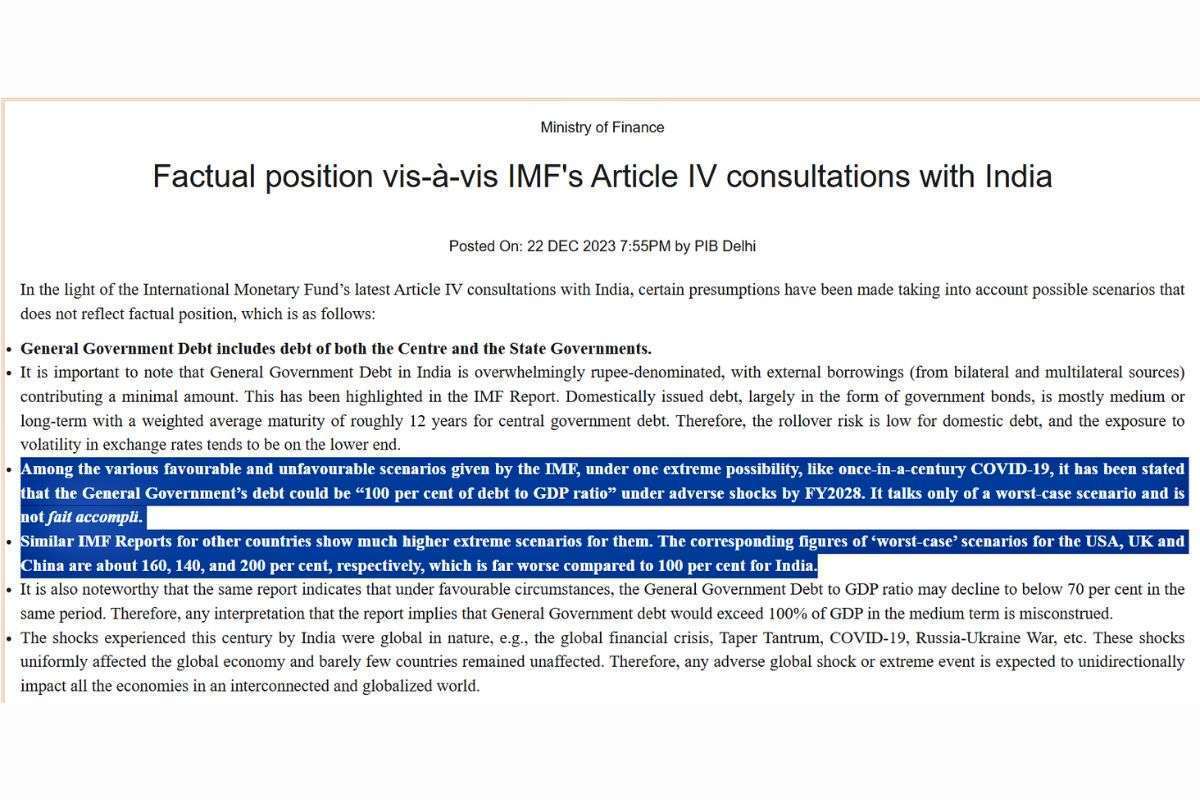
In May 2024, Finance Minister Nirmala Sitharaman, the fiscal policy’s chief architect, made a lengthy post on X comparing the debt profiles of both the UPA and NDA administrations, in addition to arguing that India’s debt, including that of states, was safe and prudent, and that the country was in a better situation than others. Taking a dig at the opposition’s financially extravagant electoral promises, she thundered, “The fact is that their government’s fiscal management is considerably better than that of the UPA even confronting the Covid-19 pandemic, in which large resources were spent on relief operations.”
An article titled ‘How well has the NDA’s live-within-your-means economic philosophy served India?‘ writes that till a certain point, the government’s overall fiscal management has been good, with our debt-to-GDP ratio under control and excellent external account management. However, fiscal and economic results are not, as economist Rathin Roy has noted.
Revenue GDP numbers have stagnated, disinvestments failed, expenditure-GDP ratio has shrunk, interest on debt, subsidies are rising, defence spending did not increase, government capital expenditure on budget has gone up, but the rise in overall central government capex (budget plus public sector) is modest, subsidies like PLI (Production Linked Incentive schemes) and free ration to 800 million appear to have become permanent freebies with no strategy to reduce the fiscal drag, he concludes.
Public Spending Cut.
Faced with reduced revenue, the government might be forced to make cuts to public spending. This can impact vital sectors and programs, as seen by reducing the quality and accessibility of services such as education, healthcare, and infrastructure.
In the healthcare sector, an article titled ‘Centre’s health expenditure down as a share of GDP or total Budget since 2018-19‘ published on July 2024, writes how the Union government’s healthcare spending may appear to be increasing at first look; however, it has consistently declined during the previous five years (2018-19 to 2023-24), both as a part of the budget and as a percentage of GDP. In reality, expenditure has hardly kept up with inflation since 2019/20. Health spending as a proportion of the overall budget has decreased from 2.4% in 2018-19 to 1.9% in 2023-24. It will be 0.28% of GDP in 2023-24, down from 0.30% before.
Healthcare spending comprises funds for health and family welfare, health research, and Ayush. Ayush’s percentage of overall government expenditure increased significantly. Spending on health research increased only modestly, with the Indian Council for Medical Research receiving 70-80% of the budget, with the exception of 2020-21, when 40% went to Covid emergency response. However, spending on health and family welfare, which is intended for national programming, the national health mission, and health system strengthening, has been significantly reduced in terms of both GDP and overall budget expenditure.
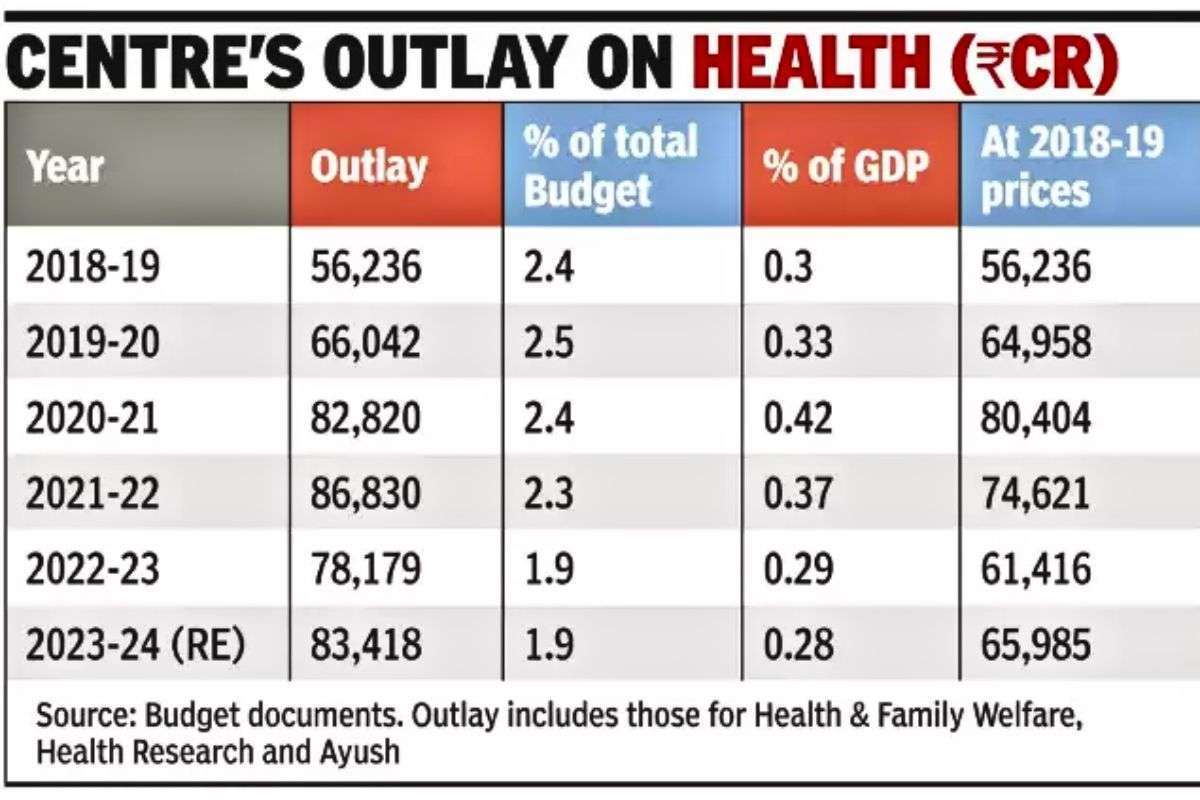
This can even be seen when, in April 2024, a medical journal, Lancet report, found that India’s healthcare spending was low at 1.2% of GDP and noted that it was among the lowest among G20 countries, although government officials refuted this claim and justified growing investments. According to government sources, spending has reached an all-time high, although out-of-pocket expenditure as a percentage of overall health expenditure has fallen.
However, if the Lancet report is ever mistaken and the government is literally spending money on the healthcare sector, the quality of healthcare being served to the citizens of India is a question of debate. For instance, last year, October’s case of Nanded Hospital, Maharashtra, shows the dismal state of the district’s principal government hospital, where it was found that at least 31 patients died due to a lack of medicines, treatment and shortage of doctors. Another is the recent case reported in August 2024 about Indore district hospital, which is already showing signs of severe structural issues, with water leaking from walls and dripping from the roof.
In the education sector, in its 2014 manifesto, the Bharatiya Janata Party-led government said that “investment in education yields the best dividend” and planned to increase public spending on education to 6% of GDP. In comparison, from 2004 to 2014, the Congress-led union government spent an average of 0.61% of GDP on education. Despite its commitment, between 2014 and 2024, the Union government allocated just 0.44% of yearly GDP to education on average.
The Interim Budget in February 2024, which includes a significant drop of more than 60% in payments to the University Grants Commission (UGC), justifies the above point, serving as a stark reminder of Jacob J. Lew’s assertion that “the budget is not merely a collection of numbers, but a reflection of our values and aspirations.” The funding for higher education has been reduced by ₹9,600 crore from the previous fiscal year’s revised estimate.
This is the second year of cuts in allocations for universities like the Indian Institutes of Technology and the Indian Institutes of Management. An article titled ‘A decade under Modi: Education spending declines, universities struggle with loans’ in February 2024 depicts a quick look at how the Modi government fared in strengthening education in India, showing that the cuts in the education sector may be one of the repercussions of the huge tax concessions given for political funding.
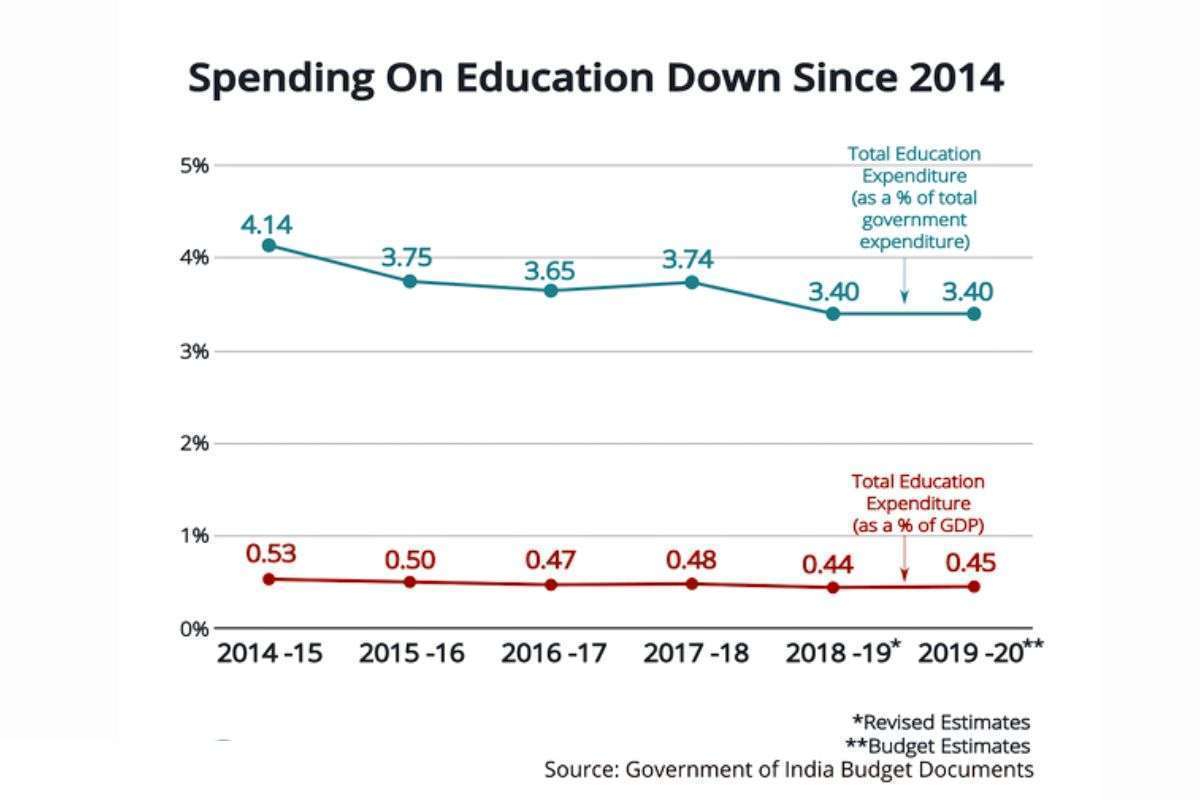
In terms of capex expenditure, it is observed that this segment has grown in the last 10 years. Effective capital expenditure refers to government spending on investments that result in long-term assets or infrastructure and contribute to economic growth. This includes funding used to construct roads, schools, hospitals, and other critical infrastructure that will benefit society for many years.
At first, it sounds good, but when you dive deep, you will get the fumes of corruption in this sector. Though funds have been allocated to capex expenditure, the collapse of terminals, airports, bridges, etc, shows India’s failing assets, apart from attributing the failures to extreme weather, displaying a lack of quality mindset and rampant corruption, as infrastructure projects involve significant financial investments.
These difficulties have shone a sharp light on Modi’s building frenzy, which authorities are relying on to drive development in the world’s fastest-growing major economy. According to Bloomberg Economics, 44.4 trillion rupees ($532 billion) of new infrastructure will be operational over the next two years. That sum represents the total value of all projects completed in the previous 11 years. Modi has presided over several of these ribbon-cutting events. Modernising infrastructure was a crucial aspect of his campaign pitch to voters in last year’s national election, which resulted in his third term as prime minister. Over the previous decade, his administration claims to have constructed 80 new airports, upgraded railways, and extended roadways by thousands of km.

Niranjan Sahoo, a senior scholar at the Observer Research Foundation in New Delhi, says accident at Terminal 1 delhi airport raises new concerns about the integrity of India’s infrastructure. “It casts the country, which aspires to be a global power, in a very negative light,” he added, calling many of the initiatives a “electoral gimmick.”
Last but not least, the concept of transparency absent from electoral funding depicts the disastrous consequences of tax concessions.
The increasing tax benefits for political donations point to a developing trend in electoral finance, implying that political parties depend increasingly largely on corporate and individual contributions. This might shift the balance of power and influence in political decision-making. In fact, in 2022-23, the majority of the expected revenue impact of Rs 3,967.54 crore, out of which Rs 2,003.43 crore, was related to corporate taxpayer donations under Section 80GGB.
How does corporate funding to politics alter political decision-making?
The answer lies in the Supreme court verdict that mentioned ‘Electoral Bonds‘ as ‘unconstitutional’ asserting the possibility of a quid pro quo in corporate funding to parties and the need for public transparency.The nexus between business, politics, and white collar crime is a global issue. India is no new to this reality, since corporate funding of politics is a controversial issue.
The history of power, bonds, and corporates.
Corporate funding in India has a history dating back to the freedom fight. During the early part of the twentieth century, the business class supported India’s quest for economic and political freedom. The Birlas were major donors to the Indian National Congress, and the corporate elite as a whole gained some influence in formulating the Congress government’s policies on economic regulation following Independence. The corporate community has given the majority of donations to poll spending since Independence despite the fact that the cost of contesting elections has risen exponentially. Party membership fees, contributions from candidates and their allies, quasi-state financing, and a levy on parliamentary income can only raise a minuscule amount of funds required for contesting elections.
In the 1960s, the Congress and the Swatantra Party—the latter founded by C. Rajagopalachari as a party advocating free enterprise—were the primary recipients of donations from large conglomerates such as the Tatas and the Birlas, which together accounted for 34% of total company contributions between 1962 and 1968. In 1969, corporate funding was completely prohibited in order to destroy the nexus between politics and business. 1985 saw the lifting of the ban. The post-liberalisation period has seen tremendous growth in corporate election finance, both via traditional means of direct contributions to political parties and through new institutional innovations such as electoral trusts.
Talking about the last decade, the decade under the Modi regime has seen much corporate funding, which raises doubt over how corporate funding was done to gain the benefit of tax concessions. It has been widely known that in recent years, the ruling party, the BJP, has regularly received far more funds than other political parties. The party received the most through electoral trusts.
In 2022-23, the Congress earned 19 paise for every Rs 100 that the BJP made from India Inc. through electoral trusts (ET) – a method in which corporate firms pool their donations into a trust and distribute the whole value to numerous political parties while remaining semi-anonymous. Since 2013, when the UPA administration implemented the plan, the BJP has reaped the maximum benefits. Over the last ten years, the party has collected more than Rs 1,893 crore from various ETs.
The BJP also received the most funds through the now ‘unconstitutional’ electoral bonds. It garnered roughly Rs 1,300 crore in 2022-23, which is seven times more than the Congress received during the same period. Electoral bonds accounted for over 61% of the BJP’s fundraising throughout the same time. Between 2018 and 2022, the BJP received roughly 57% of all donations made in this manner.
Moreover, it was found that 33 loss-making firms and entities that have been raided have given the funds through electoral bonds. Hence, these companies, many of which have suspected financials, have also benefitted from tax concessions, compromising the transparency in political funding. 5 firms in 2023-24 and eight in 2022-23 made political contributions through bonds beyond the original 7.5% cap had negative or zero net profits. It has been observed that Loss Making Firms May Have Saved More in Taxes Than Electoral Bond Expenditure because if a loss-making company obtains a contract or deal through quid pro quo, the profit they make from it does not attract tax liability because their current losses are offset against future profit.
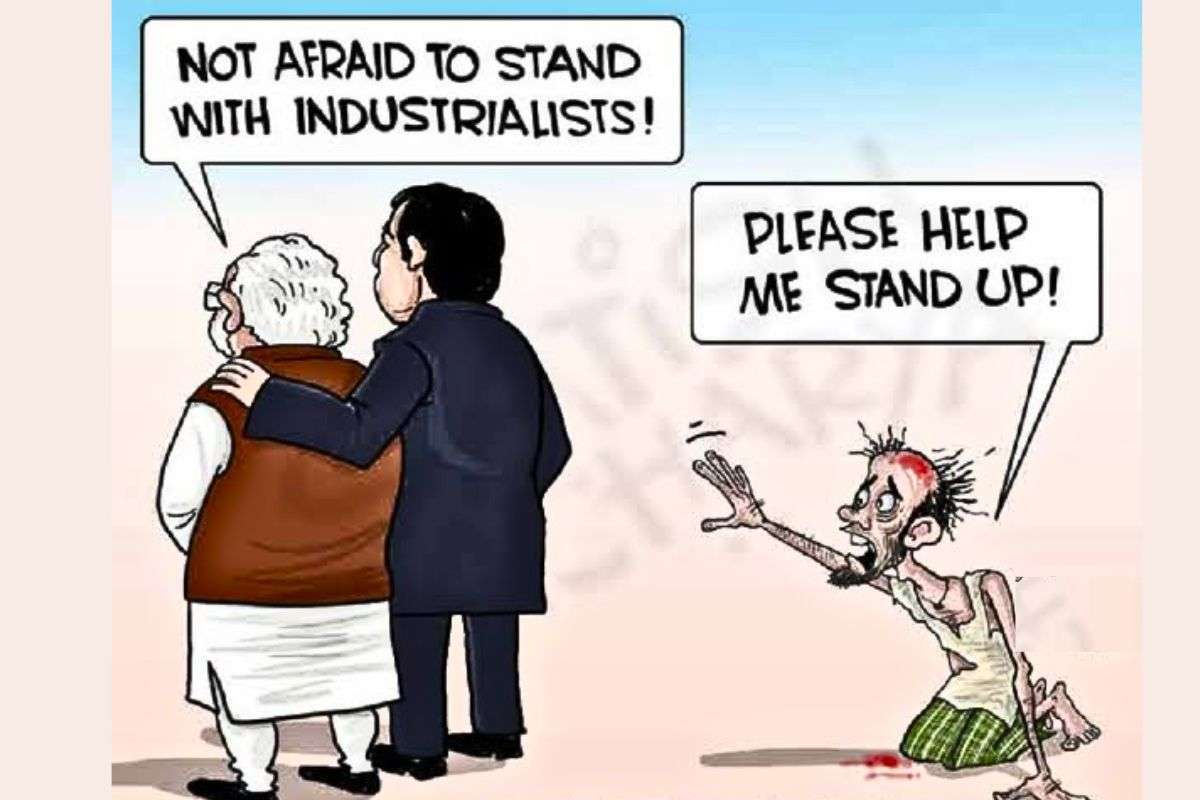
Also, tax concessions on political donations have disproportionately benefitted wealthier individuals and corporations, who are more capable of making large donations. This leads to an uneven tax burden, where high-income donors receive significant tax breaks, potentially skewing the fairness of the tax system. Indian economy’s ‘K-shaped’ recovery shows may justify this point as the rich are thriving while the poor struggle. Moreover, an article titled ‘Profits for corporates, taxes for individuals‘ dated February 2024, represents how the income tax system, which needs to be fair before anything else, now favours corporations over individuals.
Conclusion.
Therefore, tax concessions for political funding have significantly eroded the central government’s revenue by reducing taxable income and creating an opportunity cost for public spending. These exemptions not only impact fiscal health but also raise concerns about equity and transparency. The decade under Narendra Modi’s regime has seen a notable increase in corporate funding to political parties, driven in part by tax concessions that benefit both donors and recipients.
While these mechanisms were designed to encourage political participation, they have also led to significant concerns about revenue loss, transparency, and potential undue influence. As the debate continues, addressing these issues through reforms and enhanced transparency will be crucial in ensuring that political funding mechanisms support democratic integrity while maintaining fiscal responsibility.




